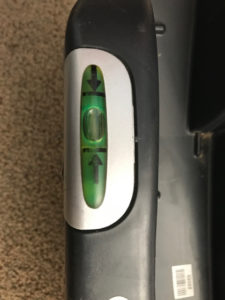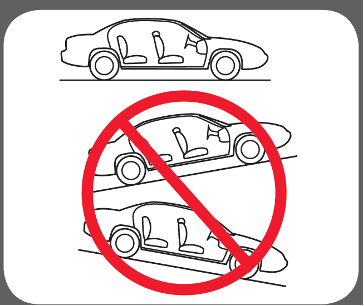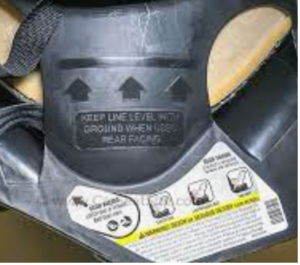For Indiana’s virtual CPS conference in June, Darrin Keiser, senior director of operational quality at Dorel Juvenile Products, gave a presentation that described why concerns about the limitations of gravity-based recline indicators have prompted Dorel to plan to shift away from using them on future models.
What is a gravity-based indicator?

Even if the term isn’t familiar, CPSTs nowadays are familiar with gravity-based indicators because they are ubiquitous. This type of recline indicator uses an object (for instance, a ball, bubble, or dial) responding to gravity within a marked zone on a CR to inform a user of the CR’s angle. Years ago, this type of indicator was introduced on a few CR models, and over the years it has become mainstream. Today, various styles can be found on the majority of RF-only, convertible, and all-in-1 models at a range of price levels.
Since a vast array of gravity-based indicator designs exist, users and CPSTs must check instructions to know how to properly read them. However, this type is generally appreciated for being easy to use because it displays the reading automatically; no judgment is required on the part of the user. Most gravity-based indicators provide a range of angles that indicate a “correct” recline zone, and several have been designed to require one range of angles for newborns and allow a more upright range for older children.
What’s the problem with gravity-based indicators?
Given their popularity, why would Dorel want to veer away from using this feature? In his presentation, Keiser described what Dorel regards as the Achilles’ heel of this indicator type: The “correct” zone is actually correct only when the vehicle is parked on level ground.
Of course, this revelation is not news; the owner’s manuals for CRs with this feature have always included a warning to read the indicator only when parked on level ground. However, Keiser’s presentation clarified that this condition may be problematic in more situations than people realize.
For instance, while most CPSTs (and even caregivers) would readily understand that they can’t rely on gravity-based recline indicators on a very steep hill or sloped driveway, Keiser pointed out that even most driveways and parking lots that appear flat are typically not level. In fact, this is by design, since a well-constructed driveway or lot has at least a gentle slope to allow for water runoff. However, it’s difficult for humans to detect this slight amount of slope. Also, the fact that owner’s manuals exaggerate warning images for effect may imply to users that only notable slopes are a problem (as in the image shown here, from a CR manual).

But Keiser indicated that even a surface that’s only slightly unlevel could make a difference in proper installation—and ultimately the safety of a child. If the surface is just a little sloped, it’s possible that setting the CR to an angle that puts the bubble, dial, ball, etc., into the approved zone can actually make the CR too upright or too reclined. (And, back to CPS basics, a CR that’s too upright could cause the child’s head to flop, potentially closing the airway during normal driving conditions, while a CR that’s too reclined places the child in a less protective position in a crash. Like Goldilocks, we work hard to find the situation that’s just right!)
What does Dorel plan to do?
Because of these concerns, Dorel has plans to phase out gravity-based indicators. Keiser said that Dorel’s aim is to design CRs that can pass FMVSS 213 testing without the need for users to refer to any indicators at all. While the company works toward that design goal, the interim plan is to turn instead to using another recline indicator with which CPSTs are already familiar: the line indicator.

Line indicators, which some companies call “level to ground” lines, are also nothing new, and many Dorel models already feature them. This type is either displayed as part of labeling (which is nice for visibility but requires the sticker to be affixed on the CR perfectly and to not peel off) or embossed or raised on the CR plastic itself (which tends to be harder to notice and see but is permanent and always accurate). Keiser didn’t indicate which style Dorel plans to use, but the company has had examples of both display styles in its product line. While this line type also has a downside (more on that in a moment), its overriding safety benefit is that it can be used to get a proper reading on any surface, whether level or sloped.
While this is a very important advantage, the disadvantage of line-type (compared to gravity-based) indicators is that they leave the assessment up to the user, and that judgment as to whether the line is level can be faulty. Challenges include whether the user has space to step back to get a good look, whether they can still see the line from that position, and whether they are able to judge what level is.
To make this easier, Dorel plans to essentially revamp the “level to ground” technique and point instead to ensuring the line is parallel with the vehicle. Because a vehicle’s running board (the threshold for the doorway) is typically* ((Manufacturers sometimes adjust the frame of load-bearing vehicles, like some pickups, so that the frame becomes level to ground when there is an average-weight load in the truck bed. In these rare exceptions, if the truck bed is empty, the running board is slightly sloped, not parallel to the ground.)) flat and parallel to the ground, the assessment of level can be made in relation to this part of the vehicle. And, since the vehicle’s running board is closer to the CR (and, arguably, an even more distinct line), a level assessment should be easier to make.
Along with these instructions, Dorel plans to refer to this feature as a “parallel-to-vehicle,” or PTV, line. It remains to be seen how this method will resonate with users, but the hope is that it will be more straightforward and that Dorel will include clear instructions with easy-to-read graphics (both on labels and in manuals). Still, this approach will not resolve line-indicator challenges for certain situations, such as when the CR is in the rear seat of a two-door vehicle or in a third row. Certainly, CPSTs will be important interpreters to assist the public when these instructions begin to appear.
Line indicators that must be parallel to the ground are, by nature, less flexible, as only one angle fits that description. However, some companies (including Dorel) have instructions and/or multiple lines that allow some angle variations for use with newborns versus older infants. Keiser didn’t indicate what type of line Dorel will use going forward.
How can CPSTs use this information?
CPSTs need to continue to follow what’s stated in CR owner’s manuals, whether working with a CR by Dorel or another brand.
However, these insights serve as a warning that a slope doesn’t have to be steep to matter when checking gravity-based indicators. A simple test for a slope would be to see if a pencil or pool noodle rolls when dropped. To measure the amount of slope, place a carpenter’s level on the ground to see if the bubble is centered. (As Keiser explained, the longer the level tool is, the more accurate the reading will be.)
Of course, even if it’s determined that the ground is not level, it’s often not possible to change locations during a checkup. A carpenter’s level can act as a guide in this situation. For instance, if a carpenter’s level shows the car faces into a downward slope, and a CR’s gravity-based indicator shows the CR is in its most upright position within the allowed zone, it would be prudent to adjust the CR to be more reclined within the allowed zone; otherwise, the CR would most certainly be too upright when it’s on level ground. According to Keiser, gas stations tend to have reliably flat surfaces, so it might be wise to advise a caregiver to recheck the indicator when they get gas. Presumably, families with a covered garage could check when the car is parked at home, as well.
For CRs with a line indicator, continue to follow instructions for level to ground. However, since the vehicle running board is typically parallel to the ground, CPSTs might want to try using this part of the vehicle when assessing the angle, as doing so can be helpful when reading any line indicator.* ((Manufacturers sometimes adjust the frame of load-bearing vehicles, like some pickups, so that the frame becomes level to ground when there is an average-weight load in the truck bed. In these rare exceptions, if the truck bed is empty, the running board is slightly sloped, not parallel to the ground.))
Lastly, do not take these warnings as a rationale for disregarding gravity-based indicators. In particular, most current RF-only models have a gravity-based indicator on the base and a line indicator on the CR shell. Check instructions; the line is usually meant for baseless installations only, while the gravity-based indicator (not the line) should be consulted when the CR is used with its base. Using the line-type indicator while the CR is in the base can yield confusing and/or inaccurate results.
